Riding the rails: It's the only way to fly
It's late afternoon, and I'm standing inside New York's JFK airport with over a dozen of my favorite relatives, when we suddenly learn that the flight back to Reagan National has been canceled due to a severe weather system in the nation's capital. Even worse, the storm has knocked out the rest of the day's flights as well.
As frequent travelers know, when weather grounds planes, there's no free ride and no free hotel–- just the prospect of lining up a set of hotel rooms (each of which can easily run $500/night in Gotham City) or scrambling to find a squad of large, luggage-ready rental cars and enough drivers willing to launch a five-hour (traffic-willing) trek to the DC area.
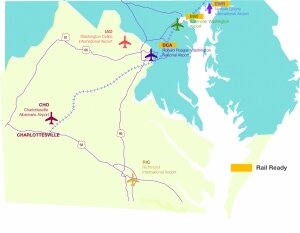 But now there's another way. Thanks to the 2004 opening of a rail link, JFK has easy access to Amtrak. For $8.50 per person and about 30 minutes of our time, the combination of the "AirTrain" and the Long Island Railroad took our voluminous group of cousins, in-laws, and tired children to Manhattan's Penn Station. And that gave us myriad options to ride Amtrak back to the D.C. area. While we chose the high-speed, high-priced Acela, which was pretty peppy, the point of this story is that America needs a transportation system with lots of pieces, pieces that fit together.
But now there's another way. Thanks to the 2004 opening of a rail link, JFK has easy access to Amtrak. For $8.50 per person and about 30 minutes of our time, the combination of the "AirTrain" and the Long Island Railroad took our voluminous group of cousins, in-laws, and tired children to Manhattan's Penn Station. And that gave us myriad options to ride Amtrak back to the D.C. area. While we chose the high-speed, high-priced Acela, which was pretty peppy, the point of this story is that America needs a transportation system with lots of pieces, pieces that fit together.
Planners call this inter-modal transportation, and it's something that can reduce auto traffic as it allows people in smaller cities like Charlottesville to seamlessly make their way–- typically via rail–- to the better long-distance options found in bigger cities. Unfortunately, the promise of an inter-modal system has not been met by reality in this country.
Let's return to JFK for a moment. It's a little pathetic that there's no direct subway line between Manhattan and New York's busiest airport, but it could be worse: there's no subway connection at all to New York's LaGuardia Airport.
And–- if I may continue the digression–- it's pretty well known why the airport now known as JFK opened in 1959 without any rail access. Back then, New York transportation policy lay in the hands of a savvy but non-visionary planner named Robert Moses. As detailed in Robert Caro's Pulitzer Prize-winning biography, The Power Broker, Moses steered the densely populated New York metropolis away from public transportation and in the direction of highways, highways, highways. As history showed, those Moses toll roads could serve as short-term cash cows but as longterm congestors. At JFK, roads can be an insulting waste of time to many of the 125,000 passengers and 35,000 airport employees who might like to leave a car at home and get some work or reading done while riding the rails.
I love CHO, the Charlottesville-Albemarle Airport, but in the past year, I've been trying to use rail to reach some of the bigger airports with their cheaper fares and better array of flights, particularly non-stops. Here's what I've found.
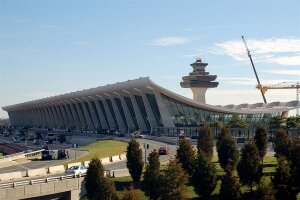 BWI. In a huge rarity, this airport not only offers easy access to Maryland commuter rail but has its own on-property Amtrak station. One recent January, the airport now named for Thurgood Marshall gave me a huge boost for a ski trip to Utah. BWI offered an affordable direct flight to Salt Lake City for about a third of the price of CHO's non-direct ticket. Luckily, the flight just happened to take off shortly after Charlottesville's new train service pulled into the BWI train station. And because I came from the Hook office downtown, I was able to walk half a mile to the Charlottesville Amtrak station with no cab fare or parking fees. Even after paying Amtrak, my travel price was less than half the CHO ticket. (Time from Charlottesville Amtrak station: 3 hours.)
BWI. In a huge rarity, this airport not only offers easy access to Maryland commuter rail but has its own on-property Amtrak station. One recent January, the airport now named for Thurgood Marshall gave me a huge boost for a ski trip to Utah. BWI offered an affordable direct flight to Salt Lake City for about a third of the price of CHO's non-direct ticket. Luckily, the flight just happened to take off shortly after Charlottesville's new train service pulled into the BWI train station. And because I came from the Hook office downtown, I was able to walk half a mile to the Charlottesville Amtrak station with no cab fare or parking fees. Even after paying Amtrak, my travel price was less than half the CHO ticket. (Time from Charlottesville Amtrak station: 3 hours.)
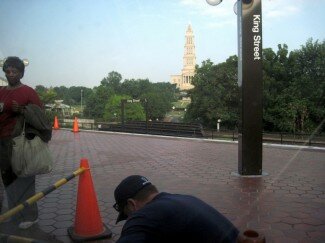 National Airport lies just two subway stops from Amtrak's Alexandria's station, shown here. PHOTO BY HAWES SPENCER
National Airport lies just two subway stops from Amtrak's Alexandria's station, shown here. PHOTO BY HAWES SPENCER
Dulles. A sexy-looking building designed by the dude who gave us the iconic TWA terminal at JFK. But like JFK, this is another giant airport thrown open to the public without a shred of rail service. And getting there from Charlottesville takes longer every year, as traffic lights bloom like mushrooms along U.S. 29, and Northern Virginians clog I-66 and Sully Road. So what was once a dependable hour and 45 minutes from downtown C'ville now takes two-and-a-half hours on a good day. And don't forget to allow at least 20 minutes to negotiate a shuttle trip to the terminal from IAD's Siberia-like "satellite parking." Alas, even when Dulles finally gets rail access, it'll come via the under-construction Metro Silver Line. Washingtonians will relish the 2016 airport opening. Then, Charlottesvillians who can deal with a couple of rail-hops and about 20 subway stops can reach Dulles without a car. (Time from Charlottesville Amtrak station: 2.5 hours.)
National. While not much better than Dulles when driving, DCA does have some serious rail access, and I was able to use a piece of that recently. After driving an hour and half to Springfield, I thought about parking in the Metro garage, but they allocate only 17 spaces to overnight parking and decline to publish the price online. So I did what any reasonable traveler would do and parked on the street by the Springfield Crossing apartment complex. While my strategy did require a quarter-mile walk to the Metro station, I got 10 days of free parking while exploring Costa Rica. 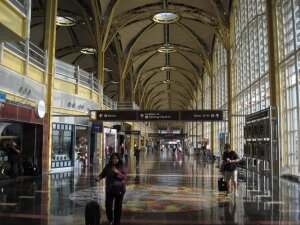
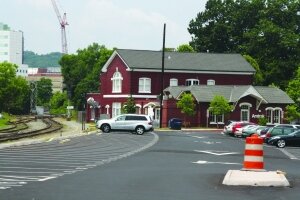
CHO. The Charlottesville-Albemarle Airport has considerable charms. It's a tiny terminal, it's never more than 25 minutes from anywhere in Charlottesville, and you can get away with arriving just 30 minutes before your flight, even less time if you do an online check-in and don't check bags. Most recently, CHO announced a 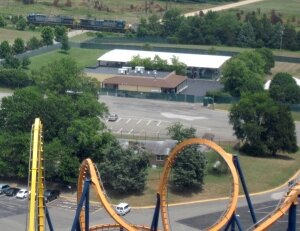
Newark. Okay, this one's a bit of a stretch because it's a lengthy train ride from Charlottesville, but like BWI, the rail station and the airport are practically the same place, with the connection here being a 3-mile monorail– sexy! Newark, aka EWR, also earns a place on this list because it offers a variety of super-cheap and international destinations. (Time from Charlottesville Amtrak station: 6.25 hours.)
So there you have it. Whether you're actually car-less or just want to be, you can now reach the flights of National, BWI, and Newark without negotiating busy urban highways or spending money at airport parking lots. And five years from now, you can add Dulles to this list. Happy summer traveling!
–this essay has been altered somewhat since its original posting last July 30.
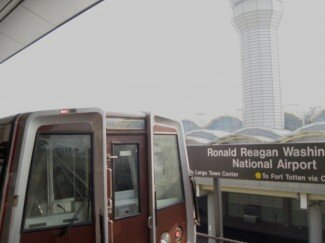
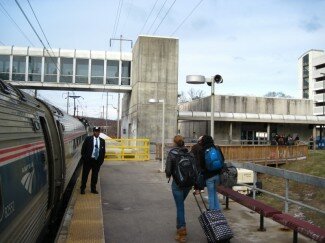
20 comments
CHARLOTTESVILLE DOES HAVE RAIL ACCESS TO NATIONAL AIRPORT!!!!
Take Amtrak from Charlottesville to the Alexandria station. The Alexandria Amtrak station is also a Metro station for the Blue and Yellow lines, both of which run two stops north directly to National.
It couldn't be an easier trip! And depending on which Amtrak train you book, the whole trip can cost just under $70 round-trip with a one-way leg taking close to two-and-a-half hours.
I've never understood why more people in Charlottesville don't know about and/or don't utilize this access to such a major airport more.
I'm a holy modal rounder. Lookin for luv in all the rong stations
Whatever you do, avoid 66 at all costs. Worst road on the East Coast.
Absolutely terrible.
Dear Commenters,
When I wrote the descriptor "access road," I simply meant Route 28/Sully Road from I-66 to the Airport which is the way I've always traveled. I should have realized that my terminology would create confusion with the Dulles Airport Access Road, an entirely different road which brings traffic in from the metropolitan area (and, yes a huge waste of time for Charlottesville travelers), so I've rewritten that paragraph to clarify.
(One of the reasons I put this essay online at least a week before print publication was to spur readers to share any useful tips that they might have. So thanks for chiming in so I can clarify.)--hawes spencer, hook journalist
Wonderful article-makes me want to hop a train tonight ! If China wins the war of the worlds, it will be because, they are pouring billions into intermodalism. Hope we can catch up.
Hear, Hear!!! excellent write-up...intermodalism is the way to go!
Right about Dulles, the ever increasing stop lights on 29 make the trip increasingly longer. I used to fly out of Dulles for the cheaper rates (Southwest) but flying into/out of Richmond makes for an easier car ride early or later with a small child.
Robert Moses did more to kill public transit than any other human. Intentionally building bridge overpasses to short and roads to narrow for busses etc, and his plans being copied by many a city planner...
In the 1920's the rich would head for the Adirondacks and the Hamptons and Robert Moses wanted a way for the working class to get out of the City, and improve their moaral fiber. At the time New York was very densely populated and Moses felt, for the middle class, roads and bridges were the pathway to space, greenery and the chance to commune with nature. It was the golden age of the automobile and the nation was car crazy. JFK didn't exist and LaGuardia was just 5 miles from the center of the city.
Word to the wise: your directions to IAD are WAY off from Charlottesville. Take 29 to 66 east to 28 north. Absolutely no need to take the access road which might even involve taking 66 to the beltway to the access road. Crazy.
AA I didn't read this the same way you did -thought the author meant taking 28 off of 66, I have always referred to that as the access road to Dulles.
Well, I thought that Hawes was referring to congestion generally in Northern Virginia, which would include 66 as well as the Dulles Access Road that one can take from Dulles to points inward.
I do a lot of flying, for a variety of reasons, but mostly its biznus. In all candor, I don't find too many deals where I am going that are so much better going from the major airports. Especially when it comes to Richmond. Usually I am looking at a difference of 20-40$, which even a nice train ride wouldn't make up for, much less the security. Security at places like Dulles are an absolute horror, even though I now have such flying status that I get to to go through premier service /1st class lines. I also don't have to worry about baggage fees and that rot.
Of course, those special deals do come from time to time, and the fact is, I would like to have the options, because I shouldn't have to depend on a car for long distance trips. Nor should guests coming to our country.
I would very much like to be able to travel up and down the Atlantic routinely without flying. Being able to commute via train into Maryland routinely like I do, instead of driving would be a lot less stressful. Especially if I can do it from right downtown.
By the way good luck with that 245$ roundtrip flight to ATL with Delta. It's easy to get the price - I have many times, but they are ALWAYS late going both directions. US Air might take you on a couple of Saab 340s or Dash-8's, but they get you there on time.
Before Robert Moses, there were no public beaches or State Parks on Long Island to bus inner city folks to, he created those as well. All of the prime recreational waterfront was in private hands or owned by towns that excluded all but their own residents. Moses' legacy can't be taken out of the context of the time it was developed in, while its true his roads and bridges didn't easily facilitate access by inner city folks to destinations of choice, he was breaking new ground at a time when railroads held a monopoly on mass transportation. And he wasn't the only one to make mistakes.
@NancyDrew:
As long as folks realize that 29N-66E-28N is the way to go. As a former NOVA resident, I can assure you that the Dulles Access Road means the road running parallel to the Dulles Toll Road (Rt 267) and originates at Rt 66 inside the Beltway and does NOT refer to Rt 28. Btw, if you hear of some horrendous traffic jam on 66E, you could take Rt 15 North off of 29 and then head east on Rt 50 to Rt 28 North (or even take some backroads off of 50 before reaching 28 if you're really familiar with the area.
@AA...
Shhhhh...don't tell eveyone that! ;)
Robert Moses had the bridge overpasses on the Southern State Parkway built at a height that would not permit buses to fit under them in order to keep poor people from being able to get to Jones Beach.
I really love the metro access to National, but I've used the BWI commuter link bus to get to MARC/Metro as well, and it's handy. The cost of a train ticket generally more than offsets the costs of parking near one of these airports...a truly great way to go.
it's a great way for murderers and criminals to travel. Yes?
I have not seen any mention of the VRE trains. I have been stressing over how to get to National. I think I will end up using VRE's free parking not out of Fredericksburg, due to their congestion and full parking, but out of Leeland Rd or Brooke station. This takes me to either Franconia/Smithfield or Alexandria for only $6 - $9, then the $3 on Metro to National.
My only conflict with this is the schedule being so early and only North in the morning and not late enough for the return trip.
Any other thoughts about VRE?